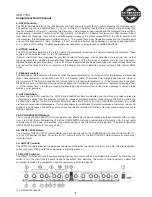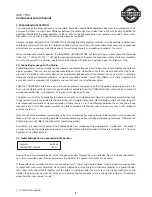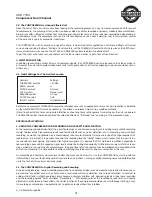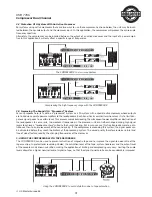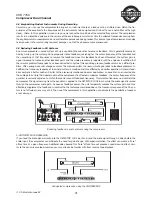
4
USB 7706
Compressor Dual Channel
Compressor/Limiter Section (Operation)
By measuring the dynamic range of musical instruments in live recording situations, you will find that extreme amplitudes
will occur which can lead to overload in subsequent signal processing equipment. In most application, these signal peaks
can lead to heavy distortion. To avoid this kind of distortion or, for example, to prevent loudspeakers from being damaged
by overload, compressors or limiters are used. These devices use automatic gain control to reduce the amplitude of loud
passages and therefore restrict the original dynamics to a desired range. This application is particularly useful in micropho-
ne recording to compensate for level changes caused by varying microphone distances. Although compressors and limiters
perform similar tasks, there is one essential difference. Limiters abruptly limit the signal above a certain level while com-
pressors control the signal ~gently" over a wider range. A limiter continuously monitors the signal and intervenes as soon
as an adjustable threshold level is exceeded. Any signal exceeding this threshold will be immediately reduced back to the
adjusted threshold level. A compressor also monitors the program continuously and has a certain threshold level. However,
in contrast to the limiter, signals exceeding the threshold are not reduced abruptly, but gradually. Above the threshold, the
signal is reduced in level relative to the amount the signal exceeds this point. Generally, threshold levels for compressors
are set below the normal operating level to allow for the upper dynamics to be musically compressed. For limiters, the
threshold level is set above the normal operating level in order to provide reliable signal limiting and thus protect subse-
quent equipment.
The extensive controls of the Compressor section provide a great range of dynamic effects: from musical and soft com-
pression to limiting signal peaks, right up to extreme and effective compression of the overall dynamics. For example, a
low ratio and very low threshold setting can be used to achieve 50ft and musical processing of the general dynamics of the
program material. Higher ratios, together with low threshold settings, create relatively constant volume (leveling) for instru-
ments by preventing the output level from significantly exceeding the threshold point (provided the OUTPUT controls in the
0 dB position). Please note that the compression of the entire program material (achieved by low threshold settings) sounds
less natural with higher ratio settings. Ratio settings in the range of 4:1 and lower affect the dynamics of the program mate-
rial less and are often used to compress the sound of a bass guitar, a snare drum or a vocal. Sensitive and moderate set-
tings are generally used in mixing and for leveling of program material in broadcasting.
In the COMPRESSOR, control of the dynamics process is achieved by means of a high quality VCA (Voltage Controlled
Amplifier) with an operating range of about 60 dB, Le., the input signal level can be reduced or increased within a range of
60 dB. Input signal levels below the adjusted threshold are not reduced. However, as soon as the input signal exceeds the
threshold level, dynamics control is activated. The amount of compression (gain reduction) is proportional to the amount
by which the input signal exceeds the threshold level. With the threshold control completely turned clockwise, the thres-
hold value is +20 dB. Since such a value will not be reached in practice, you can use it to disable the compressor section
and work exclusively either the expander/gate and the dynamic enhancer circuits.
Rotate the THRESHOLD control counterclockwise until an appropriate amount of gain reduction is indicated on the GAIN
REDUCTION meter. This operation will be accompanied by an audible drop in output level. The OUTPUT control should now
be turned clockwise to reinstate the output level. Final adjustments of the controls can then be made to suit your particu-
lar requirements, including the RATIO, ATTACK and RELEASE controls. The AUTO function of the attack and release times
provides program dependent dynamic processing, which suits most standard uses. If a “condensed” or "wider" sound pro-
cessing technique is required, the attack and release times can also be manually adjusted.
The experienced user will be in a position to specify parameters while in bypass mode and thus realize the effect before the
unit is actually switched into operation. This is important in live situations, where a signal needs to be managed efficiently
by the sound technician, without the convenience of continuous A/B comparison. For using the Compressor/Limiter as a
Limiter, you should set Ratio turned fully clockwise to co:1, switch out the AUTO function and manually adjust short Attack
and maximum Release times. Use the THRESHOLD control to set the threshold for the limiting level.
4. THRESHOLD Controls:
The THRESHOLD controls set the threshold point for the compressor sections. They have a range of -40 to +20 dB.
© US Blaster Europe BV





